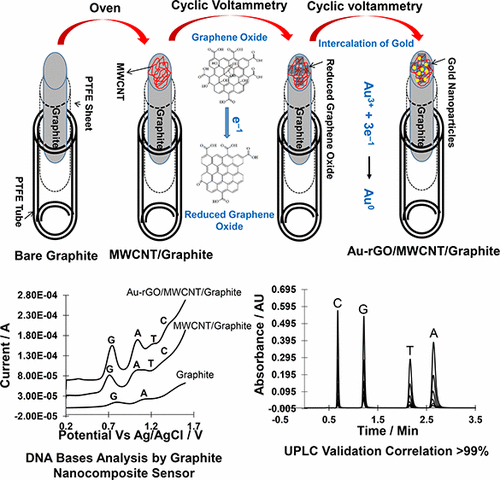当前位置:
X-MOL 学术
›
Anal. Chem.
›
论文详情
Our official English website, www.x-mol.net, welcomes your feedback! (Note: you will need to create a separate account there.)
Graphite-Based Nanocomposite Electrochemical Sensor for Multiplex Detection of Adenine, Guanine, Thymine, and Cytosine: A Biomedical Prospect for Studying DNA Damage
Analytical Chemistry ( IF 7.4 ) Pub Date : 2017-09-08 00:00:00 , DOI: 10.1021/acs.analchem.7b02432 Khan Loon Ng 1, 2 , Sook Mei Khor 1, 3
Analytical Chemistry ( IF 7.4 ) Pub Date : 2017-09-08 00:00:00 , DOI: 10.1021/acs.analchem.7b02432 Khan Loon Ng 1, 2 , Sook Mei Khor 1, 3
Affiliation

|
Guanine (G), adenine (A), thymine (T), and cytosine (C) are the four basic constituents of DNA. Studies on DNA composition have focused especially on DNA damage and genotoxicity. However, the development of a rapid, simple, and multiplex method for the simultaneous measurement of the four DNA bases remains a challenge. In this study, we describe a graphite-based nanocomposite electrode (Au-rGO/MWCNT/graphite) that uses a simple electro-co-deposition approach. We successfully applied the developed sensor for multiplex detection of G, A, T, and C, using square-wave voltammetry. The sensor was tested using real animal and plant DNA samples in which the hydrolysis of T and C could be achieved with 8 mol L–1 of acid. The electrochemical sensor exhibited excellent sensitivity (G = 178.8 nA/μg mL–1, A = 92.9 nA/μg mL–1, T = 1.4 nA/μg mL–1, and C = 15.1 9 nA/μg mL–1), low limit of detection (G, A = 0.5 μg mL–1; T, C = 1.0 μg mL–1), and high selectivity in the presence of common interfering factors from biological matrixes. The reliability of the established method was assessed by method validation and comparison with the ultraperformance liquid chromatography technique, and a correlation of 103.7% was achieved.
中文翻译:

基于石墨的纳米复合电化学传感器,用于腺嘌呤,鸟嘌呤,胸腺嘧啶和胞嘧啶的多重检测:研究DNA损伤的生物医学前景。
鸟嘌呤(G),腺嘌呤(A),胸腺嘧啶(T)和胞嘧啶(C)是DNA的四个基本组成部分。DNA组成的研究尤其集中在DNA损伤和遗传毒性上。然而,开发用于同时测量四个DNA碱基的快速,简单和多重方法仍然是一个挑战。在这项研究中,我们描述了一种使用简单的电共沉积方法的石墨基纳米复合电极(Au-rGO / MWCNT /石墨)。我们使用方波伏安法成功地将开发的传感器应用于G,A,T和C的多重检测。该传感器使用真实的动植物DNA样品进行了测试,其中T和C的水解可通过8 mol L –1的酸实现。电化学传感器表现出出色的灵敏度(G = 178.8 nA /μgmL –1,A = 92.9 nA /μgmL –1,T = 1.4 nA /μgmL –1,C = 15.1 9 nA /μgmL –1),检测下限(G,A = 0.5μgmL –1; T ,C = 1.0μgmL –1),并且在存在来自生物基质的常见干扰因子的情况下具有高选择性。通过方法验证并与超高效液相色谱技术进行比较,评估了所建立方法的可靠性,相关性达到了103.7%。
更新日期:2017-09-08
中文翻译:

基于石墨的纳米复合电化学传感器,用于腺嘌呤,鸟嘌呤,胸腺嘧啶和胞嘧啶的多重检测:研究DNA损伤的生物医学前景。
鸟嘌呤(G),腺嘌呤(A),胸腺嘧啶(T)和胞嘧啶(C)是DNA的四个基本组成部分。DNA组成的研究尤其集中在DNA损伤和遗传毒性上。然而,开发用于同时测量四个DNA碱基的快速,简单和多重方法仍然是一个挑战。在这项研究中,我们描述了一种使用简单的电共沉积方法的石墨基纳米复合电极(Au-rGO / MWCNT /石墨)。我们使用方波伏安法成功地将开发的传感器应用于G,A,T和C的多重检测。该传感器使用真实的动植物DNA样品进行了测试,其中T和C的水解可通过8 mol L –1的酸实现。电化学传感器表现出出色的灵敏度(G = 178.8 nA /μgmL –1,A = 92.9 nA /μgmL –1,T = 1.4 nA /μgmL –1,C = 15.1 9 nA /μgmL –1),检测下限(G,A = 0.5μgmL –1; T ,C = 1.0μgmL –1),并且在存在来自生物基质的常见干扰因子的情况下具有高选择性。通过方法验证并与超高效液相色谱技术进行比较,评估了所建立方法的可靠性,相关性达到了103.7%。


























 京公网安备 11010802027423号
京公网安备 11010802027423号